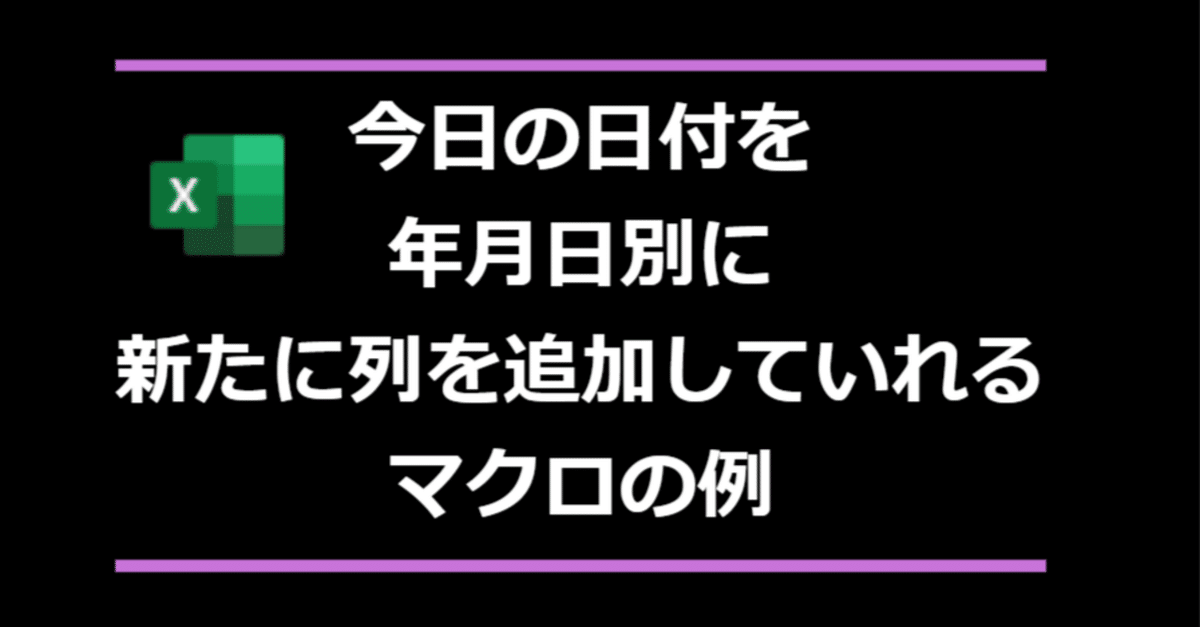
今日の日付を年月日別に新たに列を追加していれるよ
この説明は、ChatGPTで作成しています。
このVBAコードは、Excelのデータに「年」「月」「日」という3つの新しい列を追加し、それぞれに今日の「年」「月」「日」を自動で入力するものです。データを日付で管理しやすくするためのプログラムです。
仕組みの説明
A列に「年」という列があるか確認します
プログラムを実行すると、シートのA列の1行目を確認します。
もしすでに「年」という文字があれば、「年の列が既にあります」とメッセージが表示され、プログラムが終了します。
新しい列を挿入します
A列に「年」「月」「日」という列を順番に追加します。
この操作により、既存のデータは右側に移動します。
データの最終行を取得します
D列(もともとあったデータが移動した列)の最終行を確認します。
D列にデータが存在しない場合は、「D列に値がありません」とメッセージが表示されて終了します。
今日の日付を入力します
D列のデータがある行数分、A列に「年」、B列に「月」、C列に「日」を入力します。
入力される日付は、プログラムを実行した当日の日付です。
画面の更新をオフにします
処理を高速化するため、プログラムの実行中は画面の更新を一時的にオフにします。
実行が終わると、画面更新が再びオンになります。
実行結果のイメージ
プログラムを実行すると、シートの一番左側に「年」「月」「日」の列が追加され、それぞれの列に今日の日付が自動で入力されます。
注意点
既存のデータが右側に移動するため、データが崩れないように注意してください。
プログラムを実行する前に、バックアップをとっておくことをおすすめします。
関連リンク
Sub 今日の日付を年月日別に新たに列を追加していれるよ()
Application.ScreenUpdating = False
Dim ws As Worksheet
Set ws = ActiveSheet
' すでに今日の日付という列がA列にあったら実行を終了する
If ws.Cells(1, 1) = "年" Then
MsgBox "年の列が既にあります"
Exit Sub
End If
' A列に新しい列を挿入する
ws.Columns("A").Insert
ws.Cells(1, 1) = "日"
ws.Columns("A").Insert
ws.Cells(1, 1) = "月"
ws.Columns("A").Insert
ws.Cells(1, 1) = "年"
' 新しい列を3つ挿入後のD列最終行を取得
Dim lastRow As Long
lastRow = ws.Cells(ws.Rows.count, 4).End(xlUp).Row
' B列に値が1つ以下しかない場合は実行を終了する
If lastRow <= 1 Then
MsgBox "D列に値がありません"
Exit Sub
End If
' 今日の日付を必要な行数分だけ入力する
Dim i As Long
For i = 2 To lastRow
Cells(i, 1) = Year(Date)
Cells(i, 2) = Month(Date)
Cells(i, 3) = Day(Date)
Next i
Application.ScreenUpdating = True
End Sub
関連キーワード
#excel #できること #vba #日付操作 #列挿入 #データ管理 #自動化 #Excel初心者 #プログラミング学習 #VBA入門 #セル操作 #シート管理 #業務効率化 #日付入力 #年列追加 #月列追加 #日列追加 #列管理 #データ整理 #メッセージ表示
Procedure Name: Add Today's Date in Separate Columns for Year, Month, and Day
This explanation is created with ChatGPT.
This VBA code adds three new columns labeled "Year," "Month," and "Day" to an Excel sheet and automatically fills them with today's date (year, month, day). It helps organize data more effectively by associating it with a date.
How It Works
Check if the "Year" column already exists
The program checks if cell A1 in the sheet contains the word "Year."
If "Year" is already present, a message box displays, "The Year column already exists," and the program stops.
Insert new columns
The program sequentially adds "Year," "Month," and "Day" columns at the leftmost part of the sheet (column A).
Existing data shifts to the right.
Determine the last row of data
The program identifies the last row of data in column D (where the original data has shifted).
If column D is empty, a message box displays, "No data in column D," and the program stops.
Input today's date
For each row with data in column D, the program fills the corresponding cells in columns A, B, and C with today's year, month, and day.
The date corresponds to the day the program is executed.
Turn screen updates off
To make execution faster, the program temporarily disables screen updates.
Once execution is complete, screen updates are enabled again.
Expected Outcome
After running the program, new "Year," "Month," and "Day" columns are added to the leftmost part of the sheet, populated with today's date.
Cautions
Adding columns will shift existing data to the right, so ensure that this won't disrupt your data layout.
It's a good idea to create a backup before running the program.
Related Links
Related Keywords
#excel #vba #automation #dateoperations #insertcolumns #datamanagement #ExcelforBeginners #ProgrammingBasics #CellOperations #YearColumn #MonthColumn #DayColumn #TaskAutomation #SheetManagement #DataInput #Efficiency #YearMonthDay #DateAutomation #MessageBox #DataOrganization
